Hello all,
It seems there is plenty of interest so I will be sharing my extract techniques in the days/weeks to come. There are a number of methods that one can employ to extract and concentrate various substances from peppers. The simplest methods leave you with an extract that is broadly similar in taste to the original pepper but much more concentrated (in both flavor and heat). More involved methods focus on extracting primarily capsaicinoids (the hot stuff) while leaving other stuff (such as various sugars) behind. With increasingly-complex and laborious techniques, one can get ever-closer to that holy-grail of pure capsaicin. I will outline the principles of this one eventually (in another post), but unless you enjoy chemistry as a hobby and have some serious time and money to spare (or a lab of your own), you’re much better off just buying the stuff. Disappointing I know, but don’t be discouraged; you can make some great sauce and/or paint stripper with relatively little effort.
So, here is the first installment – the MacGyver approach to extraction – protocols for extraction that require only stuff already laying around the house, as well as some that might require just a trip to the grocery store. They are described in order of increasing complexity.
Note: What follows is intended for the general public and not trained chemists so PLEASE, no flames regarding the things that are not 100% technically accurate. I don’t want my plumber wasting my time telling me the intricacies of where the sh** goes and in that spirit I’m guessing most people just want hot sauce not a science lesson. If you’re more interested, however, feel free to contact me and I’d love to talk science.
This is one of the products these guides will eventually lead to:
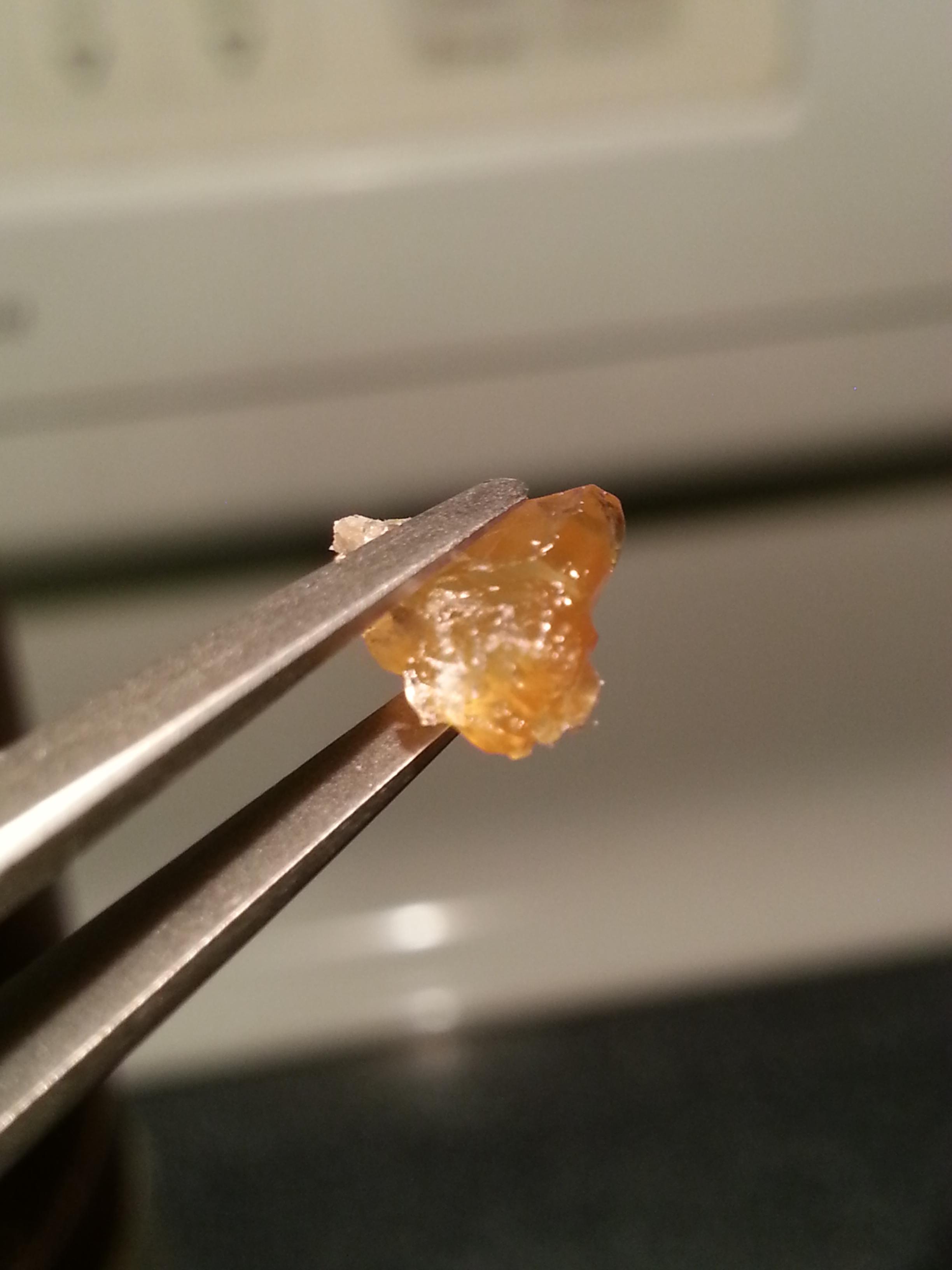
Introduction
Extraction boils down to one thing: dissolution. That is, dissolving the desired components of the pepper in an appropriate solvent. Refinement involves separation of some of the dissolved components from others, and the basic principle is equally simple: solubility. By using a solvent that selectively dissolves substantially more, say, sugar than capsaicin, one may remove the sugars from his or her extract. What is to follow will describe techniques that yield increasingly more refined extract. Which one is best for you will depend on your personal taste preferences (or laziness, as is often the case for me).
Materials and Methods
These are the materials you will need for each of the three methods below and the prepariation procedures thereof.
Method 1 Materials:
Ethanol – Use Everclear (95% ethanol) or vodka. If you use vodka, you’ll get less concentrated heat but more flavor.
Method 2 Materials:
- 95% Ethanol (Everclear or equivalent grain alcohol) - Note that most lab-grade alcohols contain additive such as benzene to stop people from drinking them so it is advisable to buy "booze-grade" ethanol
- Epsom salts (typically magnesium sulfate heptahydrate, written as MgSO4 + 7H2O)
Preparation of Epsom salts:
Make anhydrous magnesium sulfate from Epsom salts. Note that some of this will end up in your extract (it is slightly soluble in ethanol), but as long as you don’t way-overdo it with the ethanol-to-pepper ratio it shouldn’t be noticeable. I will elaborate on the process to make this later, but for now you can google “magnesium sulfate dehydration” and find plenty of info, or just do the following: Pre-heat oven to 300F. Spread a thin layer of Epsom salt on a cookie sheet and tarp it with a piece of foil (shield it from electrical elements). Put it in the oven and increase the temperature by 10 degrees every 10 minutes until you reach 450F. Once at 450F wait two hours. Check on the stuff intermittently – it should effloresce (the crystals should fall apart into a powder on their own). If it doesn’t do this by time you hit the 400F mark, take it out and crush up the large crystals a bit (don’t breath the dust). After you are done, seal the powder in an air-tight container until use.
Method 3 Materials:
- Either of the above listed materials lists depending on desired quality
- Olive or vegetable oil (or any other oil you can eat)
Method 1 Procedure: Simple reduction-style extract
This technique is very common and described in many other places, but for completeness I will include it.
1. Cut your peppers of choice up (or at least cut once to open them) and put them in the alcohol.
2. Wait. The more finely cut the peppers are the less time it will take. For a full-bodied sauce, wait until they lose color as shown in the pic of what were originally orange habaneros. In any case, wait at least a couple of days.
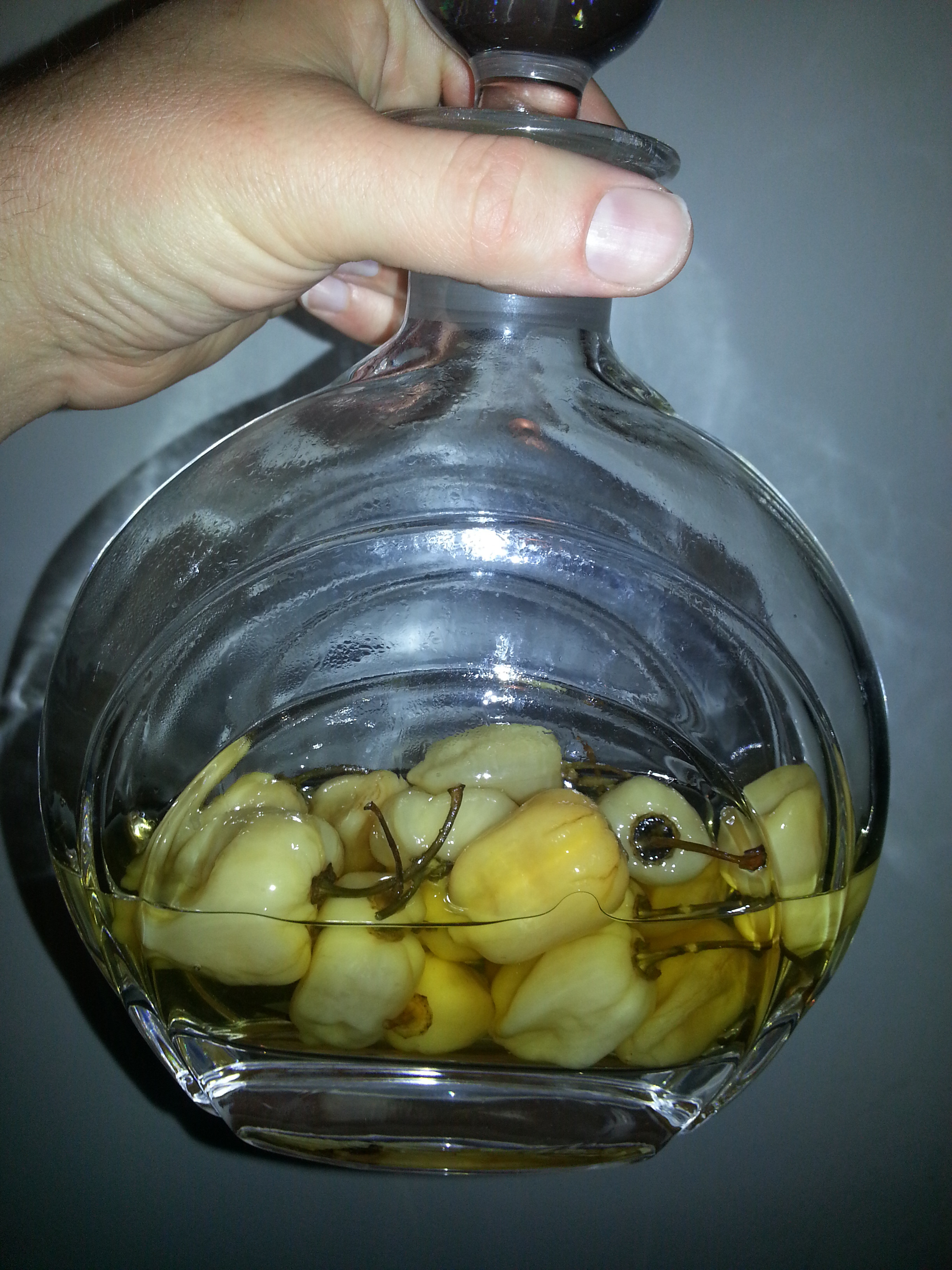
3. Pour the infused alcohol into a glass dish (preferably one that narrows toward the base), and place it in the open. In front of a fan is preferable. You can use heat if you wish but don’t go too far – the last stages must be completed slowly and at room temp for best results. You'll notice precipitates forming eventually - this is good.
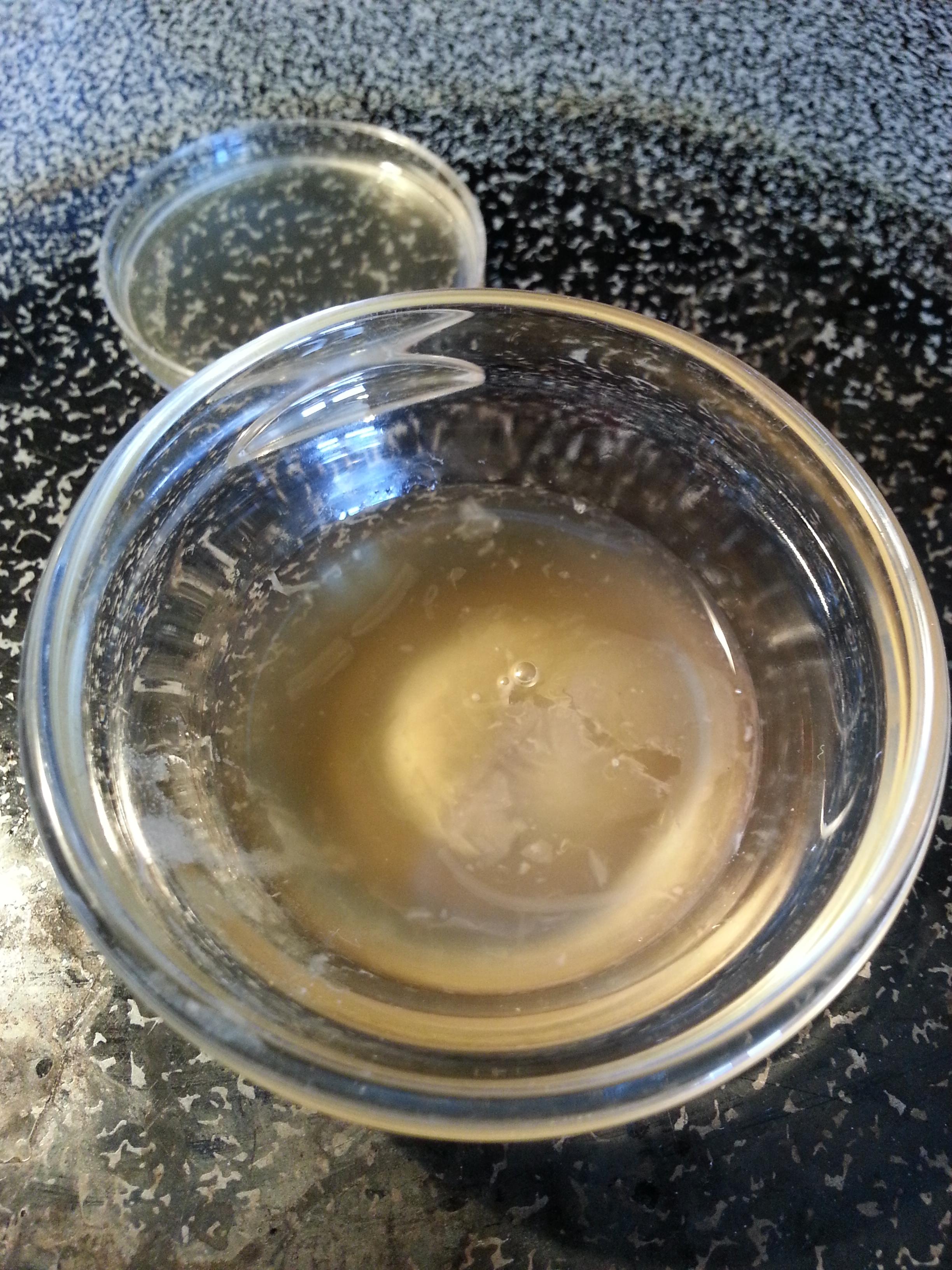
4. Wait some more. Use the extract when it is the desired consistency. It will continue to thicken and eventually crystalize if left out.
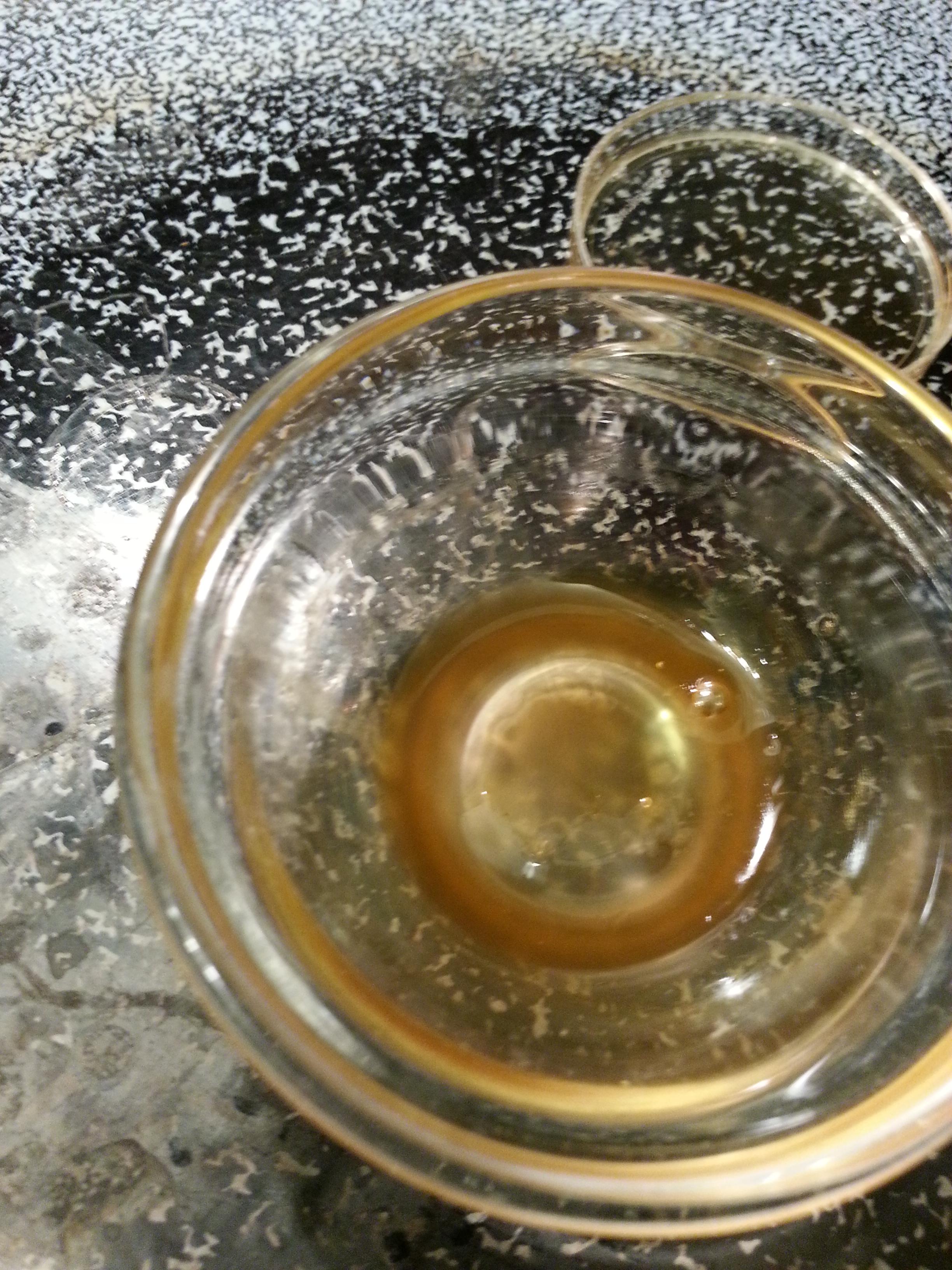
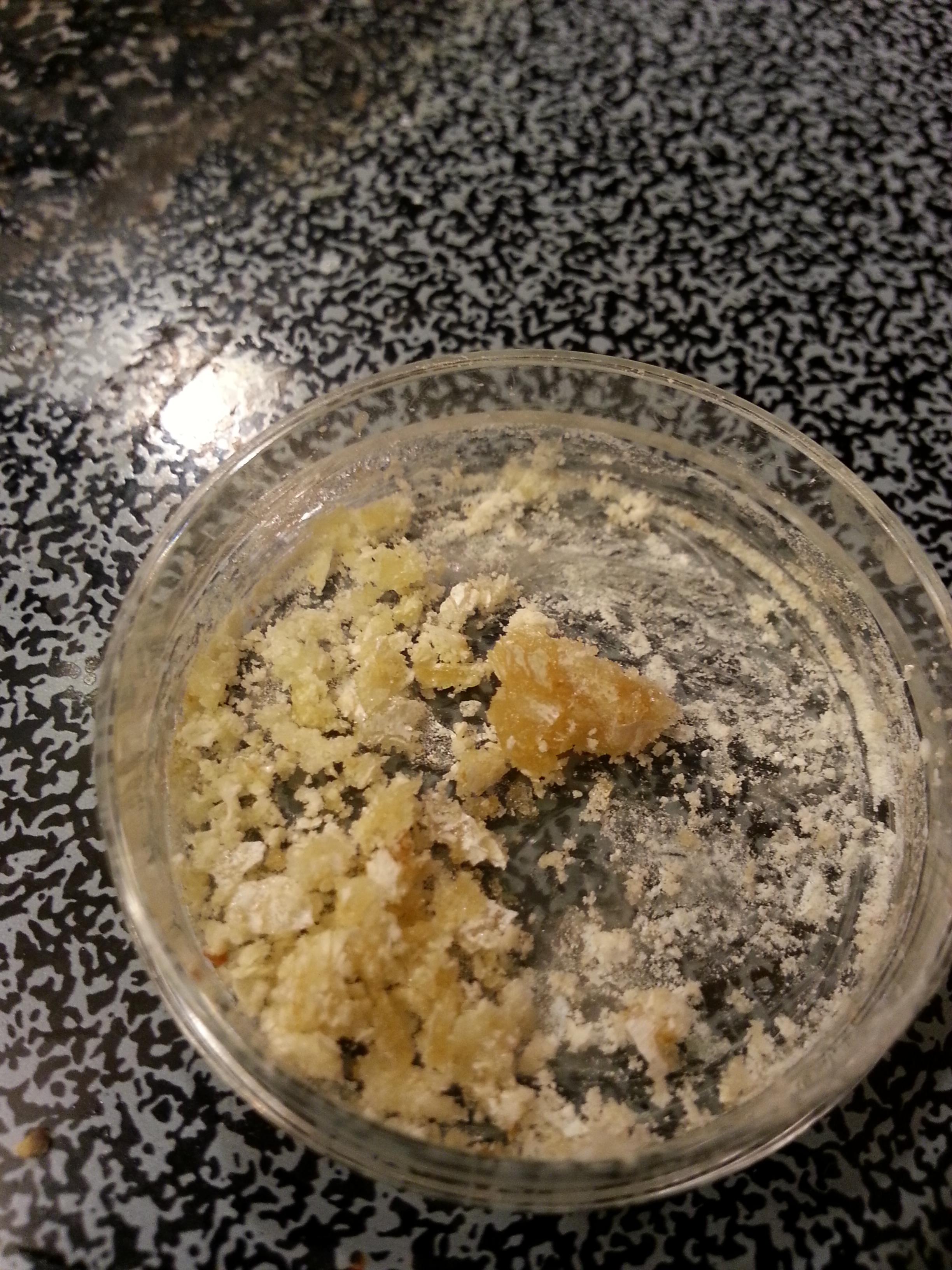
Method 2 Procedure: More heat, less sugar extract
The idea here is to leave behind as much of the other junk as possible while dissolving the capsaicinoids. This requires minimizing the water content.
1. (optional, improves results) Ferment your peppers. By fermenting your pepper first (see the threads), you can remove much of the sugar so it won’t end up in your extract. Use whatever fermentation technique you like. When it is done, take out the pepper material and rinse it briefly with cold water. Dry it thoroughly. Very low heat (200F or less) in the oven works well if you don’t want to wait, but air drying is preferable.
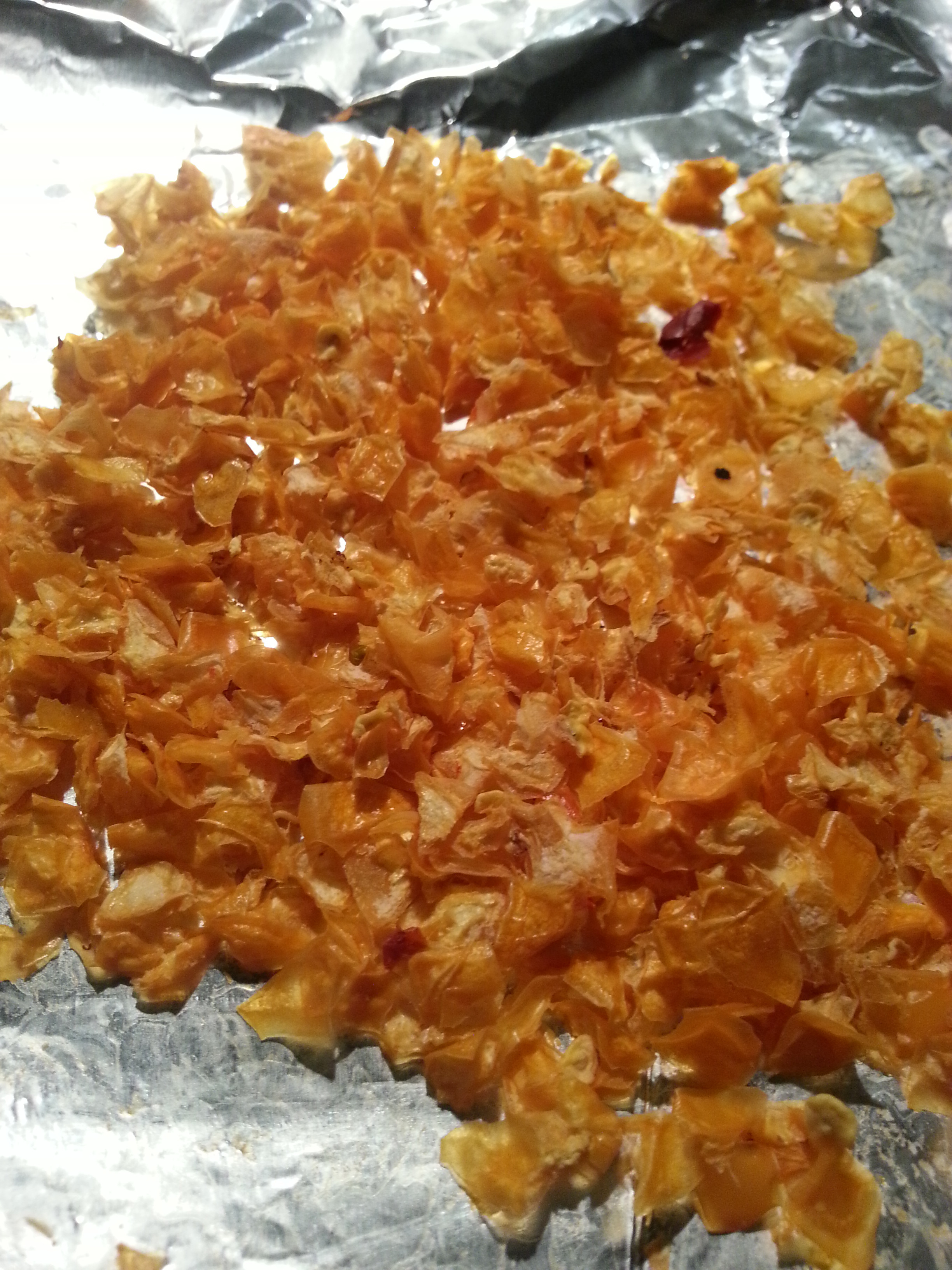
2. Dry your ethanol – This may sound strange but drying ethanol refers to removing the water from it. Everclear comes as 95% and not 100% because at 95% concentration, ethanol forms what is called an azeotrope with water. This essentially means that the alcohol and water evaporate together so distillation will not increase the concentration any further. Therefore, you must employ another method. Put the anhydrous magnesium sulfate powder into the everclear at roughly 1:10 ratio by volume (i.e. the powder should take up 10% of the total volume, more is ok). Give it a shake and set it down for at least 30 minutes (20 minutes required to dry it, give it more time if it’s still murky so the stuff can settle out).
3. Add the dried ethanol to the peppers, but don't overdo it. The ethanol level should be just above the top of the dried peppers, which should be pressed down.
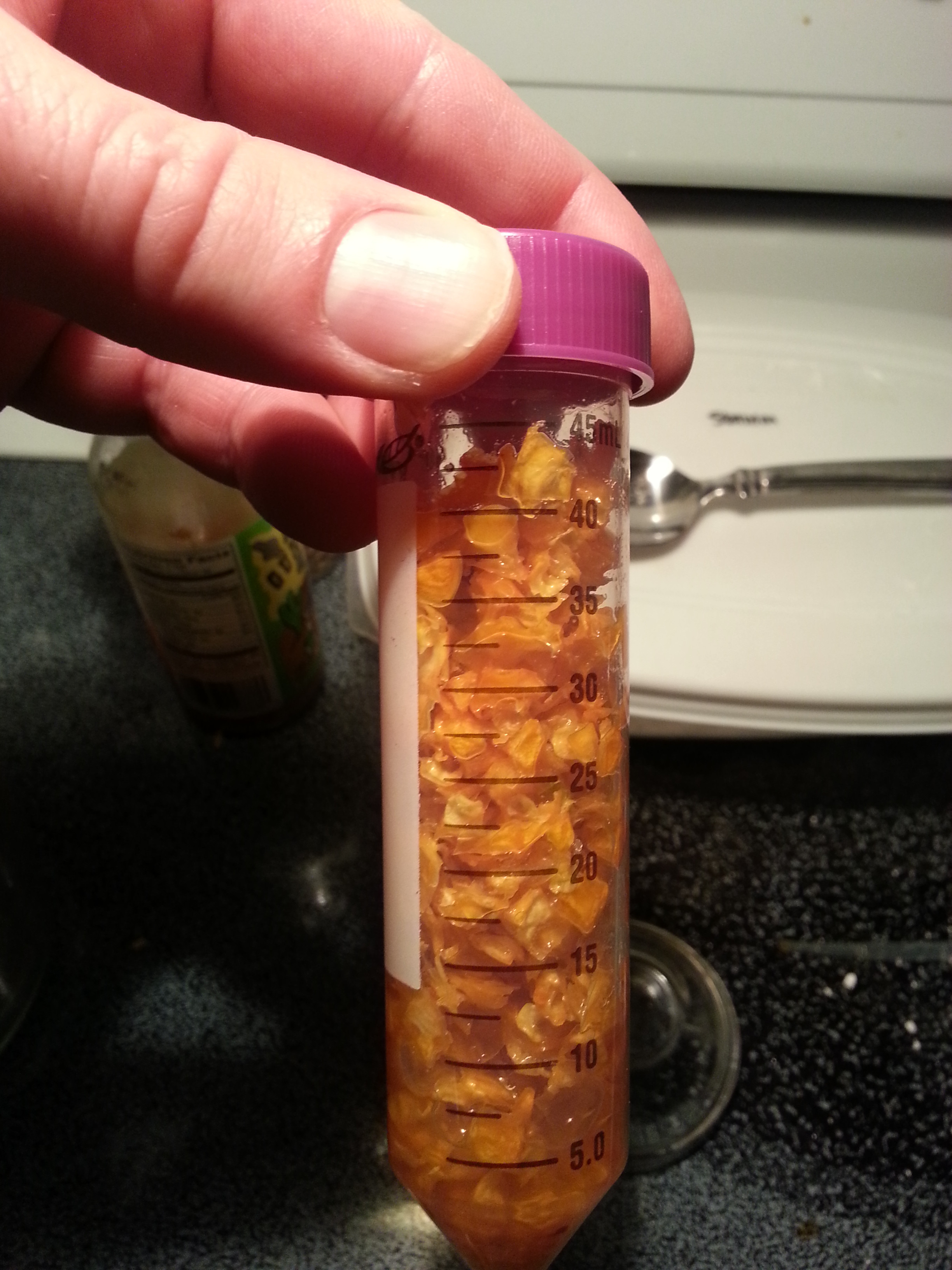
4. Continue as is method 1, but use a coffee filter if desired to remove solids before evaporation.
Method 3: Alkaline aqueous solution-oil partitioning
This technique extracts more capsaicin but you end up with a more oily substance (the capsaicinoids are dissolved in the oil). The sugars are greatly reduced, but using around-the-house products only, you have the trade-off of having extra oil and a much lower overall yield. (Diethyl ether method will prevent this and is to come in another post)
1. Obtain an extract solution using either of the above methods - which one doesn’t matter too much so the extra effort of method 2 may not be worth it if you don’t already have the materials, but the second is preferable to reduce non-capsaicinoid solutes.
2. Evaporate the solvent completely. You may use light heat to begin with, but a fan is preferable and necessary for the end stages.
3. Create an alkaline solution using baking soda (or any sodium carbonate such as pool ph-up) or preferably potassium hydroxide (KOH) or sodium hydroxide (NaOH, used in example pics). The pH should be in the 11-12 range if possible and you have something to measure it. If not, don’t worry, its not crucial, just make sure that you don’t use an acidic solution – it MUST be basic!
4. Apply a thin layer of the alkaline solution to the dish containing the concentrated solid extract. Wait, swirling occasionally.
5. Transfer the solution from the dish to a narrow tube of some sort, and add more to the dish. Repeat from step 4 until all color is gone.
6. Add a drop or oil per ~2 ml of solution (vegetable oil, olive oil, something you can eat – no motor oil unless you’re hardcore). Swirl the mixture every 10 minutes or so for an hour, preferable more but even 10 minutes is ok, you just won’t get as much cap.
7. Stand the tube straight up and let the oil coalesce at the top of the liquid. Use a pipette (if available) or something (improv it if no pipette) to remove the aqueous layer beneath the oil and set it aside. It doesn't have to be completely removed. It's not quite done in the pic, but you get the point.
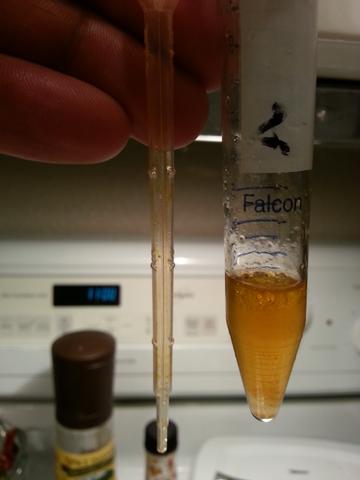
8. Add ethanol (95% or higher is best) in a volume that approximately doubles the volume removed. Swirl the tube to get everything dissolved then dump into a dish/vial/etc. Add more ethanol, swirl, and dump again.
9. Evaporate the ethanol (avoid heat if possible). You should notice that the product is much whiter - this indicates higher purity.
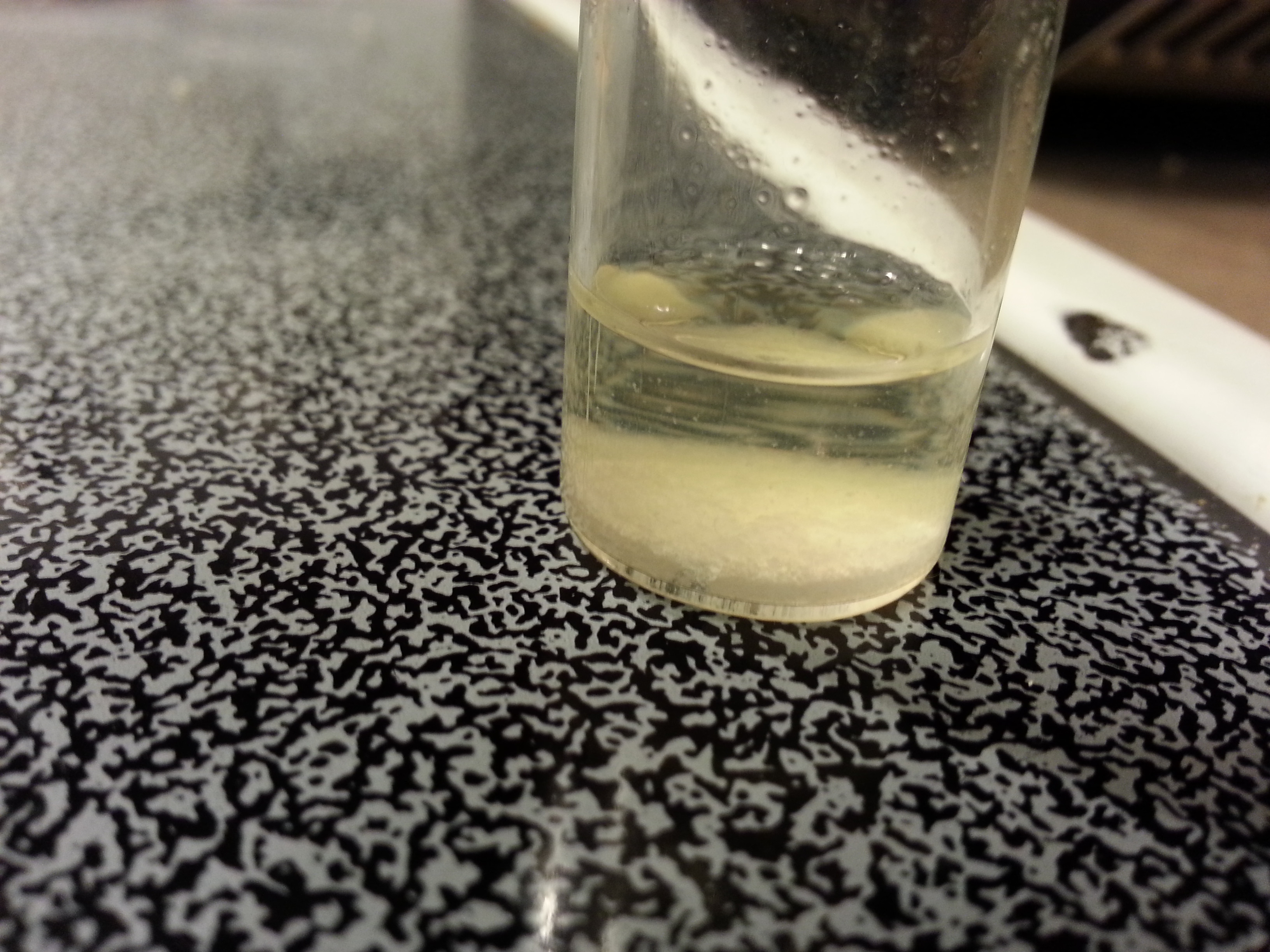
This is what you'll end up with - very little left but if done right, it'll be quite hot. Use a toothpick to taste some of the white stuff. The heat should come on slowly, then spread, then not go away for longer than usual.
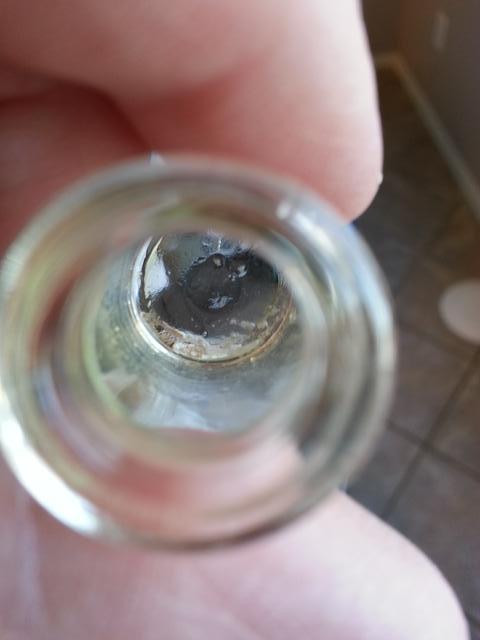
With this method, you will get very little return on investment, so to speak, but it should be hot at least.
If you want to salvage the alkaline solution removed (it's worth it), you'll need to neutralize it with a few drops of vinegar per ml - hydroxides such as NaOH are extremely hygroscopic and will absorb enough moisture from the air to create liquid around them, so they wont dry unless you neutralize them. After neutralizing, evaporate it as you would for other methods.
Bonus product
If you evaporate the liquid you filter off from your ferment, you'll get a great seasoning salt.
[wont let me post more images]
Note that in this pic it is still not ready to collect - needs to dry more. These things can take a while. The product won't be very hot, but makes a great additive to some dishes.
------------
That’s it for the level-one/simplest MacGyver methods. I’ll have more semi-MacGyver methods (i.e. you gotta buy some stuff) soon as well as advanced methods. I can't add any more pics to this post so I'm done with this one - no more editing so keep an eye out for the next post. Hopefully, you can do all this without much (if any) shopping. Contact me if you have any questions whatsoever and I'll be happy to help. Good luck!
It seems there is plenty of interest so I will be sharing my extract techniques in the days/weeks to come. There are a number of methods that one can employ to extract and concentrate various substances from peppers. The simplest methods leave you with an extract that is broadly similar in taste to the original pepper but much more concentrated (in both flavor and heat). More involved methods focus on extracting primarily capsaicinoids (the hot stuff) while leaving other stuff (such as various sugars) behind. With increasingly-complex and laborious techniques, one can get ever-closer to that holy-grail of pure capsaicin. I will outline the principles of this one eventually (in another post), but unless you enjoy chemistry as a hobby and have some serious time and money to spare (or a lab of your own), you’re much better off just buying the stuff. Disappointing I know, but don’t be discouraged; you can make some great sauce and/or paint stripper with relatively little effort.
So, here is the first installment – the MacGyver approach to extraction – protocols for extraction that require only stuff already laying around the house, as well as some that might require just a trip to the grocery store. They are described in order of increasing complexity.
Note: What follows is intended for the general public and not trained chemists so PLEASE, no flames regarding the things that are not 100% technically accurate. I don’t want my plumber wasting my time telling me the intricacies of where the sh** goes and in that spirit I’m guessing most people just want hot sauce not a science lesson. If you’re more interested, however, feel free to contact me and I’d love to talk science.
This is one of the products these guides will eventually lead to:

Introduction
Extraction boils down to one thing: dissolution. That is, dissolving the desired components of the pepper in an appropriate solvent. Refinement involves separation of some of the dissolved components from others, and the basic principle is equally simple: solubility. By using a solvent that selectively dissolves substantially more, say, sugar than capsaicin, one may remove the sugars from his or her extract. What is to follow will describe techniques that yield increasingly more refined extract. Which one is best for you will depend on your personal taste preferences (or laziness, as is often the case for me).
Materials and Methods
These are the materials you will need for each of the three methods below and the prepariation procedures thereof.
Method 1 Materials:
Ethanol – Use Everclear (95% ethanol) or vodka. If you use vodka, you’ll get less concentrated heat but more flavor.
Method 2 Materials:
- 95% Ethanol (Everclear or equivalent grain alcohol) - Note that most lab-grade alcohols contain additive such as benzene to stop people from drinking them so it is advisable to buy "booze-grade" ethanol
- Epsom salts (typically magnesium sulfate heptahydrate, written as MgSO4 + 7H2O)
Preparation of Epsom salts:
Make anhydrous magnesium sulfate from Epsom salts. Note that some of this will end up in your extract (it is slightly soluble in ethanol), but as long as you don’t way-overdo it with the ethanol-to-pepper ratio it shouldn’t be noticeable. I will elaborate on the process to make this later, but for now you can google “magnesium sulfate dehydration” and find plenty of info, or just do the following: Pre-heat oven to 300F. Spread a thin layer of Epsom salt on a cookie sheet and tarp it with a piece of foil (shield it from electrical elements). Put it in the oven and increase the temperature by 10 degrees every 10 minutes until you reach 450F. Once at 450F wait two hours. Check on the stuff intermittently – it should effloresce (the crystals should fall apart into a powder on their own). If it doesn’t do this by time you hit the 400F mark, take it out and crush up the large crystals a bit (don’t breath the dust). After you are done, seal the powder in an air-tight container until use.
Method 3 Materials:
- Either of the above listed materials lists depending on desired quality
- Olive or vegetable oil (or any other oil you can eat)
Method 1 Procedure: Simple reduction-style extract
This technique is very common and described in many other places, but for completeness I will include it.
1. Cut your peppers of choice up (or at least cut once to open them) and put them in the alcohol.
2. Wait. The more finely cut the peppers are the less time it will take. For a full-bodied sauce, wait until they lose color as shown in the pic of what were originally orange habaneros. In any case, wait at least a couple of days.

3. Pour the infused alcohol into a glass dish (preferably one that narrows toward the base), and place it in the open. In front of a fan is preferable. You can use heat if you wish but don’t go too far – the last stages must be completed slowly and at room temp for best results. You'll notice precipitates forming eventually - this is good.

4. Wait some more. Use the extract when it is the desired consistency. It will continue to thicken and eventually crystalize if left out.


Method 2 Procedure: More heat, less sugar extract
The idea here is to leave behind as much of the other junk as possible while dissolving the capsaicinoids. This requires minimizing the water content.
1. (optional, improves results) Ferment your peppers. By fermenting your pepper first (see the threads), you can remove much of the sugar so it won’t end up in your extract. Use whatever fermentation technique you like. When it is done, take out the pepper material and rinse it briefly with cold water. Dry it thoroughly. Very low heat (200F or less) in the oven works well if you don’t want to wait, but air drying is preferable.

2. Dry your ethanol – This may sound strange but drying ethanol refers to removing the water from it. Everclear comes as 95% and not 100% because at 95% concentration, ethanol forms what is called an azeotrope with water. This essentially means that the alcohol and water evaporate together so distillation will not increase the concentration any further. Therefore, you must employ another method. Put the anhydrous magnesium sulfate powder into the everclear at roughly 1:10 ratio by volume (i.e. the powder should take up 10% of the total volume, more is ok). Give it a shake and set it down for at least 30 minutes (20 minutes required to dry it, give it more time if it’s still murky so the stuff can settle out).
3. Add the dried ethanol to the peppers, but don't overdo it. The ethanol level should be just above the top of the dried peppers, which should be pressed down.

4. Continue as is method 1, but use a coffee filter if desired to remove solids before evaporation.
Method 3: Alkaline aqueous solution-oil partitioning
This technique extracts more capsaicin but you end up with a more oily substance (the capsaicinoids are dissolved in the oil). The sugars are greatly reduced, but using around-the-house products only, you have the trade-off of having extra oil and a much lower overall yield. (Diethyl ether method will prevent this and is to come in another post)
1. Obtain an extract solution using either of the above methods - which one doesn’t matter too much so the extra effort of method 2 may not be worth it if you don’t already have the materials, but the second is preferable to reduce non-capsaicinoid solutes.
2. Evaporate the solvent completely. You may use light heat to begin with, but a fan is preferable and necessary for the end stages.
3. Create an alkaline solution using baking soda (or any sodium carbonate such as pool ph-up) or preferably potassium hydroxide (KOH) or sodium hydroxide (NaOH, used in example pics). The pH should be in the 11-12 range if possible and you have something to measure it. If not, don’t worry, its not crucial, just make sure that you don’t use an acidic solution – it MUST be basic!
4. Apply a thin layer of the alkaline solution to the dish containing the concentrated solid extract. Wait, swirling occasionally.
5. Transfer the solution from the dish to a narrow tube of some sort, and add more to the dish. Repeat from step 4 until all color is gone.
6. Add a drop or oil per ~2 ml of solution (vegetable oil, olive oil, something you can eat – no motor oil unless you’re hardcore). Swirl the mixture every 10 minutes or so for an hour, preferable more but even 10 minutes is ok, you just won’t get as much cap.
7. Stand the tube straight up and let the oil coalesce at the top of the liquid. Use a pipette (if available) or something (improv it if no pipette) to remove the aqueous layer beneath the oil and set it aside. It doesn't have to be completely removed. It's not quite done in the pic, but you get the point.

8. Add ethanol (95% or higher is best) in a volume that approximately doubles the volume removed. Swirl the tube to get everything dissolved then dump into a dish/vial/etc. Add more ethanol, swirl, and dump again.
9. Evaporate the ethanol (avoid heat if possible). You should notice that the product is much whiter - this indicates higher purity.

This is what you'll end up with - very little left but if done right, it'll be quite hot. Use a toothpick to taste some of the white stuff. The heat should come on slowly, then spread, then not go away for longer than usual.

With this method, you will get very little return on investment, so to speak, but it should be hot at least.
If you want to salvage the alkaline solution removed (it's worth it), you'll need to neutralize it with a few drops of vinegar per ml - hydroxides such as NaOH are extremely hygroscopic and will absorb enough moisture from the air to create liquid around them, so they wont dry unless you neutralize them. After neutralizing, evaporate it as you would for other methods.
Bonus product
If you evaporate the liquid you filter off from your ferment, you'll get a great seasoning salt.
[wont let me post more images]
Note that in this pic it is still not ready to collect - needs to dry more. These things can take a while. The product won't be very hot, but makes a great additive to some dishes.
------------
That’s it for the level-one/simplest MacGyver methods. I’ll have more semi-MacGyver methods (i.e. you gotta buy some stuff) soon as well as advanced methods. I can't add any more pics to this post so I'm done with this one - no more editing so keep an eye out for the next post. Hopefully, you can do all this without much (if any) shopping. Contact me if you have any questions whatsoever and I'll be happy to help. Good luck!

